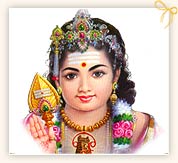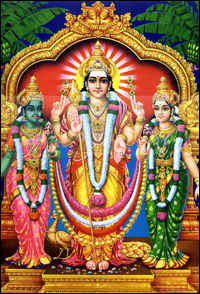Skanda Sashti 2010 – Muruga’s 6 Power Days to Shower his Universal Power
October 27, 2010Lord Muruga the Archetype is a vital force who is called upon by his ardent devotees in their hour of need & distress – it is strongly believed that Lord Muruga, the warrior God does not let them get trapped in any of the pitfalls of life.
Skanda Sashti (November 6th to 11th) is the time when Muruga’s Highest Power emerges on the earth plane. It is a time for Muruga’s devotees to absorb that power and get ready for the Golden Age. In Vedic mythology, Skanda Sashti denotes the destruction of evil by the Commander of the Army of Devas, Lord Muruga; another victory of light over dark.
Fondly denoted as Subramanya, Shanmuga, Skanda & Karthikeya, Lord Muruga is declared to be the Pleiadean deity of the Golden Age in 2012.
Dr. Pillai elaborates that “During 2012, the Sun, Earth and Alcyone, one of the Pleiadean stars, will align themselves and more of the photon light will enter the Earth. Thereafter, the Pleiadean energy will be responsible for the transformation of planet and the genetic evolution of human species.
The Golden Age signifies the re-birthing of the planet- The transformation process with Lord Muruga is readily accessible during Skanda Sashti, which will help you to possess the positive experience of this astronomical shift. The Pleiadean God will fade away the darkness and fetch you with courage.”
There is a world of knowledge behind the mythology of the 6 abodes of Lord Muruga. Although there are numerous temples for Lord Muruga across the globe; yet the 6 Battle Houses (Arupadai Veedu), holds a special emphasis among the group of shrines.
Each of the abodes to read the mythology and significance behind them:
Palani
 Significance: The Dhandayudhapani Temple at Palani is dedicated to Lord Muruga, and regarded one of his Arupadai Veedu (Six Battle Camps). The temple is situated atop the Sivagiri hills and the architecture of the temple dates back to Pandya dynasty. The temple is famous for its golden temple tower, most admirably worked. Steps are hewn into the rock and in addition, a funicular railway with three tracks and a rope-car have been provided more recently for the comfort of the pilgrims.
Significance: The Dhandayudhapani Temple at Palani is dedicated to Lord Muruga, and regarded one of his Arupadai Veedu (Six Battle Camps). The temple is situated atop the Sivagiri hills and the architecture of the temple dates back to Pandya dynasty. The temple is famous for its golden temple tower, most admirably worked. Steps are hewn into the rock and in addition, a funicular railway with three tracks and a rope-car have been provided more recently for the comfort of the pilgrims.
To keep up with the traditions of all the temples of the God Subramanian, another temple is dedicated to his worship near the foot of the Sivagiri mound. It goes by the name of “Thiru Avinankudi”, and is remarkable for the exquisite appearance of the chief deity besides the other sculptures
Pazhamudircholai
 Significance:Located near Azhagar Kovil near Madurai, is a simple shrine on the Pazhamudircholai hill with dense forests, enshrining Lord Muruga. One of the six important abodes Arupadaiveedu of Lord Muruga, it is very close to the Vishnu temple of Azhagar Kovil.
Significance:Located near Azhagar Kovil near Madurai, is a simple shrine on the Pazhamudircholai hill with dense forests, enshrining Lord Muruga. One of the six important abodes Arupadaiveedu of Lord Muruga, it is very close to the Vishnu temple of Azhagar Kovil.
At the entrance of Pazhamudircholai there is a temple called Azhagar Kovil; the deity being Lord Vishnu in the form of a protector, safeguarding Lord Muruga. Pazhamudircholai is a dense forest where “Valli, the gypsy damsel” is supposed to have lived. It is a small temple with Valli, Devayanai, and Lord Muruga in a separate shrine.
The great Tamil poetess and saint Avvaiyar had been tested for her knowledge by Lord Muruga and was blessed with bountiful knowledge in this divine spot.
Significance: Swamimalai Murugan Temple is one of the six main abodes of Muruga. According to Legends, Swamimalai is where Muruga preached; what is called as “Pranava mantra” to his own father, Shiva, after arresting ‘Brahma’ for not answering his question about Pranava Mantra.
In Swamimalai Lord Muruga is called as “Balamurugan” and “Swaminatha Swami”. The Chola Kingdom enshrined Swaminathan (one of the names of Lord Muruga), in a temple built on an artificial mound, accessed through a flight of 60 steps symbolizing the 60 years that constitute the cycle of years as per the Indian almanac.
Significance: Located near Tirupathi and Chennai, enshrines Lord Subramanian in a hill temple accessed through a flight of 365 steps. It represents the site of Muruga’s wedding with Valli.
Apart from its historical greatness, Saint Arunagirinathar has praised this hill as the chosen place for worship by the celestial beings and the favorite abode of saints to perform prolonged tapas (meditating on God for years together at a stretch). Sri Muttuswami Deekshitar, who lived 200 years ago (one of the trinity of the “Carnatic music”- the Traditional music of south India) had his inspiration in Tiruthani when Lord Muruga (in the disguise of an old man) met him on the steps of the temple and sweetened his tongue with the prasad of this temple, which provoked him to sing his first song on Lord Muruga of Tanikai.
Significance:Located near Madurai, this power vortex enshrines Lord Subramanian celebrating his marriage with Devayanai, the daughter of Lord Indra.
One of the inquisitive things about this temple is that, Lord Shiva and Vishnu face each other in the main shrine (never found in this posture in any other temple). This is because Hinduism was always apprehended into two distinct worshipping groups – the Shaivites (worshippers of Lord Shiva) and the Vaishnavites (worshippers of Lord Vishnu). The chief deity’s statue is also sculptured from a rock. Abhishekams for the presiding deity is done to Muruga’s Vel/ lance only. There are five “Theerthams”divine water sources, in and around the temple.
Significance:This power spot enshrines Lord Muruga in a vast temple with a lofty “gopuram” (temple tower) visible for miles, on the shores of the ocean in the Southern Tamil Nadu.
Thiruchendur is the place which Lord Muruga used as the base camp, before invading the demon king of Suran from Sri Lanka. Each “Arupadaiveedu” has an event mentioned in the “Purana” (legends).
Skanda Sashti or Skanda Shasti
September 21, 2009Skanda Sashti or Skanda Shasti is the most important festival dedicated to Lord Muruga or Karthikeya. It is observed in the month of Aippasi (October-November) that commemorates the victory of Lord Skanda over the Demon Surapadma.
It is believed that any devotee visiting the 6 abodes of Muruga, at least once in the lifetime gets the full measure of the Lord’s grace. Skanda Sashti, the sixth day in the bright half of the month of Aippasi (Oct 15 – Nov 15), is celebrated in all the “Shaivite temples” across Tamil Nadu with grandeur and pomp. Skanda Shasti celebrates the destruction of evil by the Supreme General Karthikeya, the younger son of Shiva. The celebration includes a dramatic enactment of “Soora Samhaaram” each year (a play where Muruga kills the demon).
The Story of Skanda Sashti:
This story of the birth of Skanda or Kumara boggles the imagination. Tormented by the asura (demon/anti God) Surapadma, the devas with Indra as the leader sought the help of the creator, Brahma. Brahma proclaimed, “only the spark of Shiva can produce the hero who will defeat the powers of the evil” Unfortunately, Shiva, the “king of the yogis” was in deep state of meditation. None of the Devas dared to disturb him… least of all convince him to create a progeny.
Upon Brahma’s suggestion, they sought the help of Parvathi and Kama (the God of Love). Parvathi agreed to help, and engaged herself in a severe penance to attract Shiva’s attention, while Kama engaged himself in the “suicidal mission” of arousing Shiva from His Samadhi.
The penance of Parvathi and the sacrifice of Kama paid off finally. Shiva was aroused from Samadhi. He opened his forehead eye and created Six Great Fire Sparks emitting heat energy. Now once again Devas could not endure the heat energy of these fire sparks. So they once again sought Lord Shiva’s grace. He called Lord Agni (God of Fire) and Lord Vayu (God of Air) to carry that great fire sparks. But the fire sparks were so powerful that they dropped them in the holy Ganges. When the fire sparks cooled down, it changed to six beautiful babies and lay on six beautiful lotus flowers. Lord Shiva arranged six beautiful maidens called ‘Karthigai Pengal’(Women of Karthiga) to look after the babies. When the babies attained a certain age Lord Shiva blessed them and made them as one person (i.e.) God Muruga. Then Lord Shiva asked His son Lord Muruga to proceed to the world of Devas on His mission of subduing the demons and freeing them from the cruel bondage of Surapadma.
Indra was restored to his kingdom and gave his daughter Devayanai in marriage to Skanda. In order not to discriminate between the rich and the poor, Muruga also married Valli the gypsy damsel.
Skanda Sashti Celebrations
Corresponding to the six days of the war over the evil forces, devotees undertake fasting, prayers and devotional singing to Lord Muruga. The 6 abodes of Muruga overflow with crowd during this period as they seek his divine grace.
For more details: http://www.astroved.com/









 Posted by Rajiv M
Posted by Rajiv M 